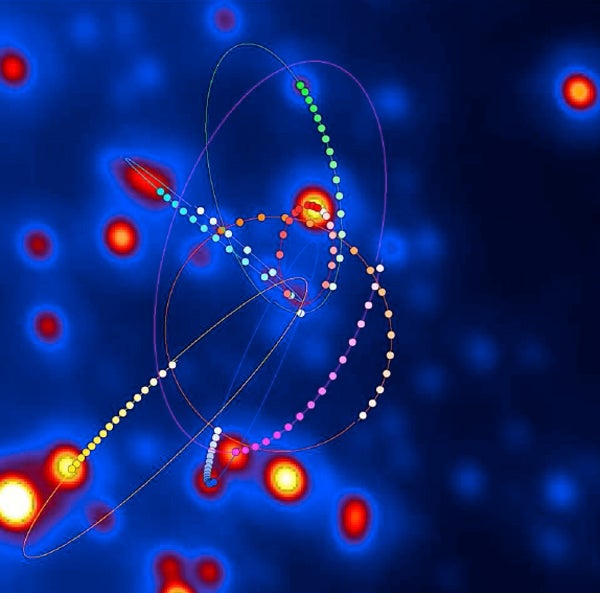|
January 30, 2012
How we see our galaxy's black hole without actually seeing it: Stanford's 2012 Bunyan lecture by astronomer Andrea Ghez
How scientists are bringing our galaxy's supermassive black hole and its environs into focus with laser guide star adaptive optics. By Dan Stober

Orbits of stars around the Milky Way's black hole. (Photo: Courtesy of Stanford Astronomy Program) Noted UCLA astronomer Andrea Ghez, who recently won astronomy's most prestigious honor for proving that a super-massive black hole resides at the center of our galaxy, will give a free public talk at Stanford on Wednesday, Feb. 1.
In an interview with the Stanford News Service, Ghez, a professor of physics and astronomy at the University of California-Los Angeles, described our cozy solar system as a quiet suburb of the Milky Way, far, far away from the busy metropolis lying near the black hole at the center of the galaxy.
There, the conditions are extreme. Orbiting stars fly by at millions of miles per hour. Near the surface of the black hole, gravity is so powerful that nothing, not even light, can escape, Ghez said. The black hole itself is unimaginably dense, "like jamming 4 million suns into our solar system."
Earlier this month, Ghez won the prestigious Crafoord Prize from the Royal Swedish Academy of Sciences for capturing images that established that stars are indeed circling a massive black hole at the center of our galaxy. She shared the award with German astronomer Reinhard Genzel. "It's a very big prize," said Stanford's Vahe Petrosian, a physics professor who is the chairman of the university's Astronomy Program. "It's sort of the Nobel Prize for astronomy."
Ghez and her team employed new technology for telescopes at the W. M. Keck Observatory on the summit of Mauna Kea, on the island of Hawaii, that produced the images of the orbiting stars, even though the black hole itself, of course, could not be seen.
At Stanford, Ghez's talk will focus on the ever-improving "adaptive optics" for telescopes that correct for some of the blurring caused by Earth's atmosphere, producing startlingly clear images. "It's been like surfing this giant wave of technology," she said.
Ghez describes herself as a "moon-landing kid" who wanted to be an astronaut but ended up a math major and an astronomer. "I think of everything as a puzzle," she said. In 2008, she won a MacArthur "genius" Fellowship.
Ghez will give the 29th Annual Bunyan Lecture, Unveiling the Pulse of Our Galaxy, at 7:30 p.m. on Wednesday, Feb. 1, in the Braun Auditorium in the Mudd Chemistry Building, 333 Campus Drive.
On Thursday, she will present a technical seminar, Bringing our Galaxy's Supermassive Black Hole and its Environs into Focus with Laser Guide Star Adaptive Optics, at 4 p.m. in the SLAC KIPAC third-floor conference room at Stanford's SLAC National Accelerator Laboratory.
The Bunyan Lecture is named for James T. Bunyan, a member of the Hoover Institution whose will specified that his estate endow lectures that "inquire into man's changing vision of the cosmos and of human destiny as revealed in the latest discoveries in the fields of astronomy and space exploration."
-30-
|